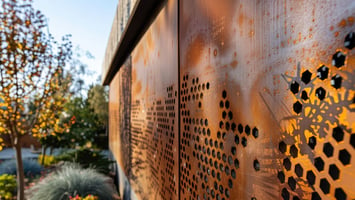In the world of construction and engineering, choosing the right metal for projects in harsh...
Kryton Metals Blog
Why Stainless Steel Makes Sense for Metal Fabrication Projects

Stainless steel is a popular choice for high-quality metal fabrication due to its durability, strength, and excellent corrosion resistance. Although it may not always be the most cost-effective or easy to machine, it often becomes the material of choice for many teams when the project requirements call for superior longevity and quality. In this article, we’ll examine the unique advantages of stainless steel in various metal fabrication projects and explore why specific industries prefer this metal.
How Stainless Steel Is Made
Stainless steel is an alloy that is produced by melting and combining different elements. The process begins with the smelting of iron ore in a blast furnace, where the ore is heated to extremely high temperatures, producing molten iron. This molten iron, containing a high concentration of carbon, is then processed to reduce its carbon content and other impurities.
The purified iron is combined with chromium—usually about 10-20% of the final product's composition—and often nickel or other elements, depending on the desired properties of the stainless steel. Chromium is the crucial ingredient, as it forms a protective layer of chromium oxide on the surface of the steel when exposed to oxygen, providing the signature corrosion resistance.
This alloy is then heated, cooled, and finally rolled into sheets or formed into various shapes to create the stainless-steel products we use today. Given its strength, durability, and resistance to rust and corrosion, stainless steel is a preferred material for many metal fabrication projects.
7 Benefits of Stainless Steel for Metal Fabricators
Manufacturers favor stainless steel over other materials because it supports high-quality metal fabrication in several ways:
#1. Versatility
Stainless steel is incredibly versatile due to its strength, resistance to rust, and its ability to withstand extreme temperatures. Its strength and durability make it ideal for use in demanding industries, like construction for building infrastructure, automotive for vehicle parts, and healthcare for surgical instruments. Furthermore, because it doesn't corrode easily, it's perfect for applications exposed to water or harsh chemicals, such as in kitchen appliances and food production, chemical processing plants, or even outdoor art installations.
#2. Corrosion Resistance
Some products need an extended shelf life. Often, stainless steel helps producers attain it by providing long-term airtightness and built-in rust prevention. The metal doesn’t corrode easily and outlasts other materials in harsh or abrasive environments.
#3. Heat Resistance
Stainless steel is resistant to extreme temperatures, providing durability in the cold and heat. That means fabricators can design products without worrying about diverse environmental conditions. Some grades of stainless steel can be welded easily.
#4. Hygenic
Stainless steel is often applauded for its hygienic properties, making it a popular choice in sectors such as healthcare, food and beverages, and pharmaceuticals. Its smooth, non-porous surface inhibits the growth of bacteria and other microorganisms, making it easy to clean and sanitize. This trait, combined with its resistance to corrosion and chemicals, allows stainless steel to maintain its integrity even after repeated sterilization processes. Its ability to sustain a high level of cleanliness helps prevent contamination and ensures the safety of the end product, whether it's food, medicine, or a medical device.
#5. Durability
Many furniture and appliance manufacturers rely on stainless steel because of its ultra-durable properties. Engineers can design kitchen appliances, bedding, tables, cabinets, and other household/restaurant objects. Stainless steel offers excellent impact resistance and strength, making it suitable for durable products and items in high-traffic areas.
#6. Environmental Sustainability
Stainless steel stands out as an environmentally sustainable choice due to its long-lasting durability and high recyclability. Its robust nature minimizes the need for frequent part replacement, thus reducing resource consumption and waste generation. Furthermore, old stainless-steel parts can be effectively recycled into new products, contributing to a circular economy and aiding in conservation efforts.
#7. Long-Term Value
Stainless steel can provide tremendous value for many years. Due to its corrosion-resistant properties and durability, parts don’t need to be replaced as often—this alone can have a positive impact on long-term value. Especially in extreme environments, other materials could require untimely and costly repairs or replacements.
Cons of Stainless Steel
Using stainless steel might not work for all projects. Here’s what you need to know about its limitations:
- Stainless steel products can be more expensive, but this is often due to the components of the alloy (nickel and chromium) that make stainless steel corrosion-resistant.
- While some stainless-steel grades are non-magnetic, others are magnetic. The magnetic properties depend on the exact composition of the alloy.
- Stainless steel is not fireproof, but it generally has excellent heat resistance, which makes it suitable for many high-temperature applications.
How to Determine If Stainless Steel Is Right For Your Project
Could stainless steel make the most sense for your metal fabrication project? Consider these factors:
- Determine your budget: Consider whether stainless steel could save you money over more expensive alternatives for your project.
- Consider the possibilities: Discuss the pros and cons of each material option with your fabrication team.
- Look for examples: Research other products made with stainless steel to evaluate where your design stands in the industry and think about what your competitors are doing with stainless steel or other alloys to stay ahead of the curve.
- Consult your team: Ask engineers and fabricators to explain the details of your project and keep communication flowing through each stage.
Stainless steel can be an ideal choice for fabricating metals in extreme temperatures and a practical solution for products that will be exposed to harsh environments, weather changes, and other challenging conditions. Learn about the KRYTON Metals fabrication process, or explore our blog for more industry insight and tips.



